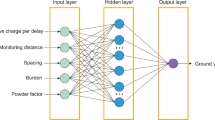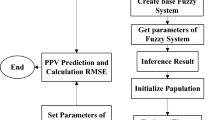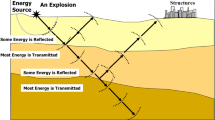Abstract
Blasting has been widely recognized as an economical and viable method in geo-engineering projects. However, the induced ground vibration in terms of peak particle velocity (PPV) potentially can damage the nearby environment and inhabitants. Therefore, more accurate prediction of the PPV can lead to reduce undesirable and hazardous effects of blasting. With the increase in the computational power, wide variety of predictive PPV models using numerical tools and data mining approaches have been presented. In this paper, the optimum predictive PPV model was specified using generalized feedforward neural network (GFFN) structure integrated with a novel automated intelligent setting parameter approach. Subsequently, two new optimized hybrid models using GFFN incorporated with firefly and imperialist competitive metaheuristic algorithms (FMA and ICA) were developed and applied on 78 monitored events in Alvand–Qoly mine, Iran. According to analyzed metrics, the predictability level of hybrid GFFN-FMA dedicated 6.67% and 20% progress than GFFN-ICA and optimum GFFN. The pursued performance using precision–recall curves and ranked accuracy criteria also exhibited superior improvement in GFFN-FMA. Sensitivity analyses implied on the importance of the distance and burden as the most and least effective factors on predicted induced PPV in the study area.












Similar content being viewed by others
Abbreviations
- GFFN:
-
Generalized feed forward neural network
- FMA:
-
Firefly metaheuristic algorithm
- ICA:
-
Imperialistic competitive metaheuristic algorithm
- PPV:
-
Peak particle velocity
- MAs:
-
Metaheuristic algorithms
- FT:
-
Fitness function
- ANN:
-
Artificial neural network
- MLP:
-
Multilayer perceptron
- GSN:
-
Generalized shunting neuron
- TA:
-
Training algorithm
- AF:
-
Activation function
- QP:
-
Quick propagation
- CGD:
-
Conjugate gradient descent
- QN:
-
Quasi-Newton
- L–M:
-
Levenberg–Marquardt
- MO:
-
Momentum
- Log:
-
Logistic
- Hyt:
-
Hyperbolic tangent
- Lin:
-
Linear
- AUC:
-
The area under the curve
- ROC:
-
Receiver-operating characteristics
References
Abbaszadeh Shahri A, Asheghi R (2018) Optimized developed artificial neural network based models to predict the blast-induced ground vibration. Innov Infrastruct Solut 3:34. https://doi.org/10.1007/s41062-018-0137-4
Sołtys A, Twardosz M, Winzer J (2017) Control and documentation studies of the impact of blasting on buildings in the surroundings of open pit mines. J Sustain Min 16(4):179–188. https://doi.org/10.1016/j.jsm.2017.12.004
Tripathy GR, Shirke RR, Kudale MD (2016) Safety of engineered structures against blast vibrations: a case study. J Rock Mech Geotech Eng 8(2):248–255. https://doi.org/10.1016/j.jrmge.2015.10.007
Ak H, Iphar M, Yavuz M, Konuk A (2009) Evaluation of ground vibration effect of blasting operations in a magnesite mine. Soil Dyn Earthq Eng 29(4):669–676. https://doi.org/10.1016/j.soildyn.2008.07.003
Taheri K, Hasanipanah M, Bagheri Golzar S, Abd Majid MZ (2016) A hybrid artificial bee colony algorithm-artificial neural network for forecasting the blast-produced ground vibration. Eng Comput. https://doi.org/10.1007/s00366-016-0497-3
Verma AK, Maheshwar S (2014) Comparative study of intelligent prediction models for pressure wave velocity. J Geosci Geomatic 2(3):130–138. https://doi.org/10.12691/jgg-2-3-9
ISRM (1992) Suggested method for blast vibration monitoring. Int J Rock Mech Min Sci Geomech Abst 29(2):145–146. https://doi.org/10.1016/0148-9062(92)92124-U
Kahriman A (2002) Analysis of ground vibrations caused by bench blasting at can open-pit lignite mine in Turkey. Environ Earth Sci 41:653–661. https://doi.org/10.1007/s00254-001-0446-2
Rajabi AM, Vafaee A (2019) Prediction of blast-induced ground vibration using empirical models and artificial neural network (Bakhtiari Dam access tunnel, as a case study). J Vib Control 26(7–8):520–531. https://doi.org/10.1177/1077546319889844
Xue X, Yang X (2014) Predicting blast-induced ground vibration using general regression neural network. J Vib Control 20(10):1512–1519. https://doi.org/10.1177/1077546312474680
Ambraseys NR, Hendron AJ (1968) Dynamic behavior of rock masses: rock mechanics in engineering practices. Wiley, London
Davies B, Farmer IW, Attewell PB (1964) Ground vibrations from shallow sub-surface blasts. Engineer 217:553–559
Duvall WI, Petkof B (1959) Spherical propagation of explosion of generated strain pulses in rocks. USBM, RI-5483.
Langefors U, Kihlstrom B (1963) The modern technique of rock blasting. Wiley, New York
Nicholls HR, Johnson CF, Duvall WI (1971) Blasting vibrations and their effects on structures. United States Department of Interior, USBM, Bulletin, p 656
Roy PP (1993) Putting ground vibration predictors into practice. Coll Guard 241:63–67
Dowding CH (1985) Blast vibration monitoring and control. Prentice-Hall Inc, Englewood’s Cliffs
Hagan TN (1973) Rock breakage by explosives. In Proceedings of the national symposium on rock fragmentation, Adelaide, 1–17.
Hudaverdi T (2012) Application of multivariate analysis for prediction of blast-induced ground vibrations. Soil Dyn Earthq Eng 43:300–308. https://doi.org/10.1016/j.soildyn.2012.08.002
Radojica L, Kostić S, Pantović R, Vasović N (2014) Prediction of blast-produced ground motion in a copper mine. Int J Rock Mech Min Sci 69:19–25. https://doi.org/10.1016/j.ijrmms.2014.03.002
Verma AK, Singh TN (2011) Intelligent systems for ground vibration measurement: a comparative study. Eng Comput 27(3):225–233. https://doi.org/10.1007/s00366-010-0193-7
Mohamed MT (2011) Performance of fuzzy logic and artificial neural network in prediction of ground and air vibrations. Int J Rock Mech Min Sci 48:845–851
Lawal AI, Idris MA (2020) An artificial neural network-based mathematical model for the prediction of blast-induced ground vibrations. Int J Environ Stud 77(2):318–334. https://doi.org/10.1080/00207233.2019.1662186
Iphar M, Yavuz M, Ak H (2008) Prediction of ground vibrations resulting from the blasting operations in an open-pit mine by adaptive neurofuzzy inference system. Environ Geol 56:97–107. https://doi.org/10.1007/s00254-007-1143-6
Xue X (2019) Neuro-fuzzy based approach for prediction of blast-induced ground vibration. Appl Acoust 152:73–78. https://doi.org/10.1016/j.apacoust.2019.03.023
Yang H, Hasanipanah M, Tahir MM, Tien Bui D (2020) Intelligent prediction of blasting-induced ground vibration using ANFIS optimized by GA and PSO. Nat Resour Res 29:739–750. https://doi.org/10.1007/s11053-019-09515-3
Dindarloo SR (2015) Peak particle velocity prediction using support vector machines: a surface blasting case study. J South Afr Inst Min Metall 115(7):637–643. https://doi.org/10.17159/2411-9717/2015/V115N7A10
Khandelwal M (2011) Blast-induced ground vibration prediction using support vector machine. Eng Comput 27(3):193–200. https://doi.org/10.1007/s00366-010-0190-x
Nguyen H, ChoiY BXN, Thoi TN (2020) Predicting blast-induced ground vibration in open-pit mines using vibration sensors and support vector regression-based optimization algorithms. Sensors 20(1):132. https://doi.org/10.3390/s20010132
Tian E, Zhang J, Tehrani MS, Surendar A, Ibatova AZ (2018) Development of GA-based models for simulating the ground vibration in mine blasting. Eng Comput 55:849–855. https://doi.org/10.1007/s00366-018-0635-1
Yu Z, Shi X, Zhou J, Chen X, Qiu X (2020) Effective assessment of blast-induced ground vibration using an optimized random forest model based on a Harris Hawks optimization algorithm. Appl Sci 10(4):1403. https://doi.org/10.3390/app10041403
Zhang X, Nguyen H, Bui X, Tran Q, Nguyen D, Bui DT, Moayedi H (2020) Novel soft computing model for predicting blast-induced ground vibration in open-pit mines based on particle swarm optimization and XGBoost. Nat Resour Res 29:711–721. https://doi.org/10.1007/s11053-019-09492-7
Abbaszadeh Shahri A, Asheghi R, Khorsand Zak M (2020) A hybridized intelligence model to improve the predictability level of strength index parameters of rocks. Neural Comput Appl. https://doi.org/10.1007/s00521-020-05223-9
Grosan C, Abraham A (2011) Hybrid intelligent systems. In: Intelligent systems. Intelligent systems reference library, vol 17, pp 423–450. Springer, Berlin Heidelberg, https://doi.org/10.1007/978-3-642-21004-4_17
Bekdaş G, Nigdeli SM, Kayabekir AE, Yang XS (2019) Optimization in civil engineering and metaheuristic algorithms: a review of state-of-the-art developments. In: Platt G, Yang XS, Silva Neto A (eds) Computational intelligence, optimization and inverse problems with applications in engineering. Springer, Cham, pp 111–137. https://doi.org/10.1007/978-3-319-96433-1_6
Bianchi L, Dorigo M, Gambardella LM, Gutjahr WJ (2009) A survey on metaheuristics for stochastic combinatorial optimization. Nat Comput 8(2):239–287. https://doi.org/10.1007/s11047-008-9098-4
Azimi Y, Khoshrou SH, Osanloo M (2019) Prediction of blast induced ground vibration (BIGV) of quarry mining using hybrid genetic algorithm optimized artificial neural network. Measurement 147:106874. https://doi.org/10.1016/j.measurement.2019.106874
Bui X, Jaroonpattanapong P, Nguyen H, Tran QH, Long NQ (2019) A novel hybrid model for predicting blast-induced ground vibration based on k-nearest neighbors and particle swarm optimization. Sci Rep 9:13971. https://doi.org/10.1038/s41598-019-50262-5
Faradonbeh RS, Monjezi M (2017) Prediction and minimization of blast-induced ground vibration using two robust meta-heuristic algorithms. Eng Comput 33:835–851. https://doi.org/10.1007/s00366-017-0501-6
Nguyen H, Drebenstedt C, Bui X, Bui DT (2020) Prediction of blast-induced ground vibration in an open-pit mine by a novel hybrid model based on clustering and artificial neural network. Nat Resour Res 29:691–709. https://doi.org/10.1007/s11053-019-09470-z
Shang Y, Nguyen H, Bui X, Tran Q, Moyaedi H (2020) A novel artificial intelligence approach to predict blast induced ground vibration in open-pit mines based on the firefly algorithm and artificial neural network. Nat Resour Res 29:723–737. https://doi.org/10.1007/s11053-019-09503-7
Agrawal A, Gans J, Goldfarb A (2018) Prediction machines: the simple economics of artificial intelligence. Harvard Business Press, Boston
Yang XS (2008) Nature-inspired metaheuristic algorithms. Luniver Press
Yang XS (2013) Multiobjective firefly algorithm for continuous optimization. Eng Comput 29(2):175–184. https://doi.org/10.1007/s00366-012-0254-1
Atashpaz Gargari E, Lucas C (2007) Imperialist competitive algorithm: an algorithm for optimization inspired by imperialistic competition. Proc IEEE Congr Evol Comput. https://doi.org/10.1109/CEC.2007.4425083
Asheghi R, Abbaszadeh Shahri A, Khorsand Zak M (2019) Prediction of uniaxial compressive strength of different quarried rocks using metaheuristic algorithm. Arab J Sci Eng 44:8645–8659. https://doi.org/10.1007/s13369-019-04046-8
Atashpaz-Gargari E, Hashemzadeh F, Rajabioun R, Lucas C (2008) Colonial competitive algorithm, a novel approach for PID controller design in MIMO distillation column process. Int J Intell Comput Cybern 1(3):337–355. https://doi.org/10.1108/17563780810893446
Furman GG (1965) Comparison of models for subtractive and shunting lateral-inhibition in receptor-neuron fields. Kybernetik 2:257–274. https://doi.org/10.1007/BF00274089
Arulampalam G, Bouzerdoum A (2003) Expanding the structure of shunting inhibitory artificial neural network classifiers. IJCNN IEEE. https://doi.org/10.1109/IJCNN.2002.1007601
Abbaszadeh Shahri A, Renkel C, Larsson S (2020) Artificial intelligence models to generate visualize bed rock level—a case study in Sweden. Model Earth Syst Environ 6:1509–1528. https://doi.org/10.1007/s40808-020-00767-0
Ghaderi A, Abbaszadeh Shahri A, Larsson S (2018) An artificial neural network based model to predict spatial soil type distribution using piezocone penetration test data (CPTu). Bull Eng Geol Env 78:4579–4588. https://doi.org/10.1007/s10064-018-1400-9
Vida I, Bartos M, Jonas P (2006) Shunting inhibition improves robustness of gamma oscillations in hippocampal interneuron networks by homogenizing firing rates. Neuron 49:107–117. https://doi.org/10.1016/j.neuron.2005.11.036
Abbaszadeh Shahri A (2016) Assessment and prediction of liquefaction potential using different artificial neural network models: a case study. Geotech Geol Eng 34:807–815. https://doi.org/10.1007/s10706-016-0004-z
Stehman S (1997) Selecting and interpreting measures of thematic classification accuracy. Remote Sens Environ 62(1):77–89. https://doi.org/10.1016/S0034-4257(97)00083-7
Asheghi R, Hosseini SA, Sanei M, Abbaszadeh Shahri A (2020) Updating the neural network sediment load models using different sensitivity analysis methods: a regional application. J Hydroinf 22(3):562–577. https://doi.org/10.2166/hydro.2020.098
Saltelli A, Ratto M, Andres T, Campolongo F, Cariboni J, Gatelli D, Saisana M, Tarantola S (2008) Global sensitivity analysis: the primer. Wiley
Author information
Authors and Affiliations
Corresponding author
Additional information
Publisher's Note
Springer Nature remains neutral with regard to jurisdictional claims in published maps and institutional affiliations.
Rights and permissions
About this article
Cite this article
Abbaszadeh Shahri, A., Pashamohammadi, F., Asheghi, R. et al. Automated intelligent hybrid computing schemes to predict blasting induced ground vibration. Engineering with Computers 38 (Suppl 4), 3335–3349 (2022). https://doi.org/10.1007/s00366-021-01444-1
Received:
Accepted:
Published:
Issue Date:
DOI: https://doi.org/10.1007/s00366-021-01444-1




